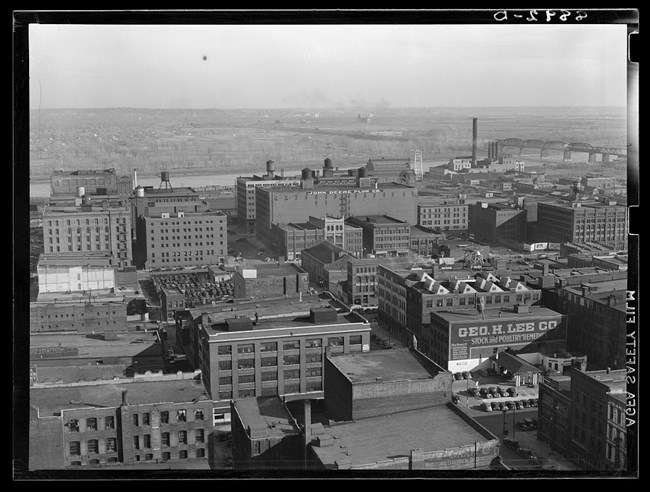Much of Omaha's growth can be attributed to many commercial enterprises. To help you learn more about the city's commercial development, this page is divided into a historical overview, followed by a listing of historic properties that represent the city's commercial history.
Overview

Vachon, John, photographer. Wholesale district. Omaha, Nebraska. United States Nebraska Omaha Douglas County, 1938. Nov. Photograph. https://www.loc.gov/item/2017762778/
Omaha grew because of the plans of Council Bluff’s entrepreneurs for a hub west of the Missouri, but the city’s success as a frontier town is due more to historical accident than careful planning. Omaha became a boom town thanks to the discovery of gold in Cherry Creek, Colorado, in spring 1859. Eager to test their luck in the search for gold, emigrants outfitted themselves for the long journey in Omaha. Smaller, rival frontier towns such as Nebraska City could not accommodate the thousands of people heading west, making Omaha the central jumping off point. While adventurers made Omaha a major outfitting city, steamboats bringing goods across the Missouri stimulated the economy while stagecoach and overland freighter companies traveled west from Omaha to Colorado and beyond.
Omaha’s economy was greatly stimulated with the arrival of the transcontinental railroad which brought job opportunities, causing a spike in population and commercial activity. The importance of manufacturing on Omaha’s economy grew as firms produced bricks, nails, fences, boilers, and asphalt, while also processing metals from western mining regions. Wholesaling, however, played an even larger role in the economy of Omaha. New transportation and communication methods – the railroad and the telegraph – allowed Omaha entrepreneurs, called jobbers, to purchase goods directly from manufacturers and sell them to store owners. By buying in bulk, jobbers created large scale buying and selling networks throughout the West. The growth of the jobbing industry spurred a demand for space, fueling warehouse construction in downtown Omaha. Jobbers operated in multiple areas of Omaha: the Old Market Historic District and the Omaha Rail and Commerce Historic District on the early south side and the Nicholas Street Historic District to the north. All were optimal locations near rail and water routes.
Western cattlemen and capitalists found a common business venture for the burgeoning city – the livestock industry. In 1883 cattlemen and businessmen founded the Union Stockyard Company, purchasing farmland south of Omaha. Cattle were shipped from Wyoming where they were fed and kept overnight in roughly 5,000 cattle pens before being moved to Chicago. The Union Stockyard Company soon constructed packing plants and a $65,000 plant for hog slaughter.
South Omaha was founded in 1884 as a meat packing center. As laborers flocked to town, they purchased suburban lots where they could build comfortable homes near the stockyard and packing plants. In the 1890s, South Omaha’s population grew from 8,000 to 26,000 people, and by 1920 the stockyards and packing plants employed over 13,000 people. The population of South Omaha grew so rapidly it earned the moniker “Magic City.” South Omaha was annexed by the City of Omaha in 1915. The South Omaha Main Street Historic District along South 24th Street represents the neighborhood’s history as a commercial hub for the meatpacking industry. Today, this same corridor reflects the intersectionality between Latino and European immigrants who established themselves in South Omaha during the heyday of the meatpacking industry. The livestock industry would remain strong through the 1920s, reflected in the Livestock Exchange Building which the center of the industry.
In the first decades of the twentieth century, Omaha boasted a diverse collection of commercial pursuits ranging in scope from local to national. Due in part to improved transportation and communication systems, the wholesale grocery trade began to grow. Between 1894 and 1915 The residential area around Stabrie Grocery near Omaha’s central business district transitioned to transportation and commerce, facilitating the use of the building for a wholesale grocer.
Benson residents frequented numerous neighborhood stores in the Benson Commercial Historic District, especially the National Register-listed Olson’s Market. Built in 1917, the family-owned meat market was a staple the everyday lives of local residents.
Built in downtown Omaha one year before Olson’s Market was opened in Benson, the Omaha Ford Motor Company Assembly Plant provides a stark contrast to the community meat market. The assembly plant in Omaha was one of many throughout the nation that mass-produced automobiles for the Ford Company, reflecting the rise of large national corporations.
Post-World War II Omaha witnessed a shift from an economy dominated by processing to a service-based economy. The decentralization of grocery and meatpacking activities caused the influence of those businesses to decline while the insurance, banking, finance, and real estate industries grew. The Northwestern Bell Telephone Company and the Northern Natural Gas Company experienced rapid expansion due to an increase in demand for both telephone service and natural gas. Both companies constructed impressive headquarters during the 1950s which punctuate the rise of Omaha as a regional center for service industries.
Much like Omaha’s economic history, business activity in Omaha today is not limited to one dominate sector. Instead, the economy is extremely diversified and includes agricultural, food processing, financial, insurance, transportation, healthcare, and educational businesses and institutions.
You can find the historic properties under this Story – along with others throughout Omaha – by visiting the Travel Omaha, NE Map.
Explore Omaha's Historic Stories
Last updated: April 5, 2023
